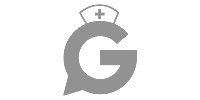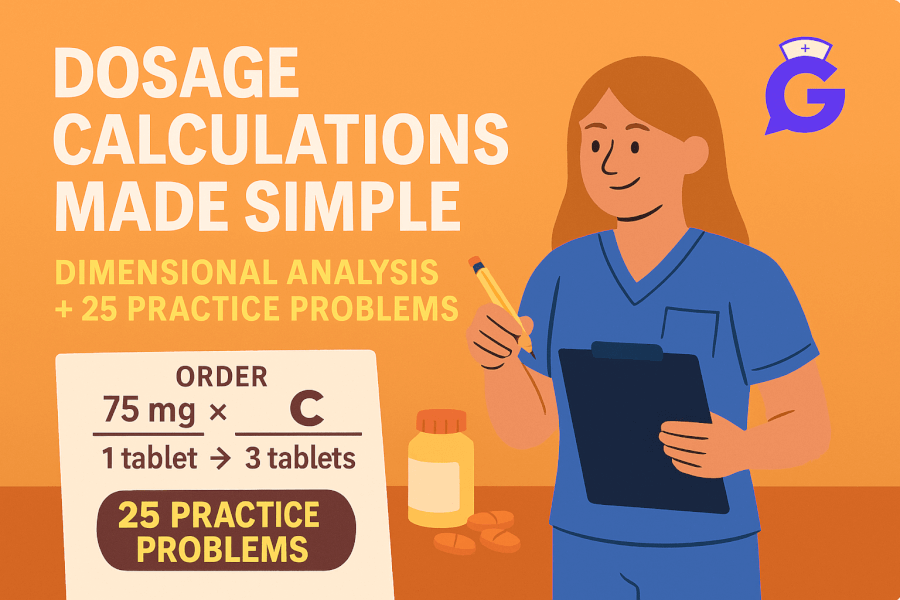New to our NCLEX Pharmacology series? Start here:
- NCLEX Pharmacology Part 1 – Core PK/PD Concepts
- Part 2 – Drug‑Dosage Calculations & High‑Yield Classifications
- Part 3 – Medication Safety Essentials & Smart Study Strategies
Once you’ve reviewed those, dive into the cardiovascular pharmacology cheat‑sheet below.
Why Cardiovascular Pharmacology Matters
- 13–19 % of the NCLEX® is pharmacological and parenteral therapies.
- The Next‑Generation NCLEX tests clinical‐judgment—understanding why drugs work, what can go wrong, and how to respond quickly and safely.
Foundational Pharmacology for Safe Practice
Pharmacokinetics (ADME) — What the body does to the drug
| Phase | Key Points | NCLEX Pearl |
|---|---|---|
| Absorption | Route, drug form, first‑pass effect | Oral meds may need higher doses than IV because of first‑pass metabolism |
| Distribution | Protein binding, tissue perfusion | Only the free drug is active—low albumin ↑ toxicity risk |
| Metabolism | Mostly hepatic (CYP‑450) | Liver impairment = dose ↓ or longer interval |
| Excretion | Mostly renal | Check BUN/Cr; poor kidneys → drug accumulation |
Pharmacodynamics — What the drug does to the body
- MOA (Mechanism of Action): how a drug produces its effect (receptor agonist, enzyme inhibitor, etc.).
- Therapeutic effect vs. adverse effect: knowing the MOA predicts both.
- Clinical judgment: if you know why a drug lowers BP, you know what vitals to monitor and which side effects to anticipate.
The “Rights” of Medication Administration
Right Patient • Drug • Dose • Route • Time • Documentation • Reason • Response • Refuse
Each “Right” involves critical thinking, not just a checklist.
Key Cardiovascular Drug Classes – NCLEX Deep Dive
I. Drugs Affecting the Renin‑Angiotensin‑Aldosterone System (RAAS)
ACE Inhibitors (‑pril)
| Cheat‑Sheet | |
|---|---|
| Examples | Lisinopril • Captopril • Enalapril |
| MOA | Blocks Ang I → Ang II conversion → vasodilation & ↓ aldosterone |
| Indications | HTN • HF • post‑MI • diabetic nephropathy |
| Side‑Effects | Angio‑edema • Dry cough • ↑ K⁺ • first‑dose hypotension |
| Nursing | Monitor BP & K⁺ • watch for angio‑edema • avoid pregnancy |
| Mnemonic | A C E → Angio‑edema, Cough, Electrolytes |
Quick NCLEX vocab tune‑up before the exam?
Review our
50 Must‑Know Nursing Terms for the 2025 NCLEX — complete with definitions, examples, and quick tips
to make every question feel familiar.
ARBs (‑sartan)
- MOA: block Ang II receptors (no cough).
- NCLEX alerts: hyper‑K⁺, hypotension, angio‑edema (rare), contraindicated in pregnancy.
II. Beta‑Adrenergic Blockers (‑lol)
| Cardio‑selective | Non‑selective | |
|---|---|---|
| Examples | Metoprolol • Atenolol | Propranolol |
| 4 B’s (major risks) | Bradycardia • low BP • Bronchospasm | plus Blood‑glucose masking |
| Nursing | Hold HR < 60/SBP < 90 • caution in asthma/COPD • taper off |
NCLEX Antidote: severe bradycardia → give glucagon (± atropine).
III. Calcium‑Channel Blockers (CCBs)
Dihydropyridines (‑dipine)
- MOA: arterial vasodilation.
- Side‑effects: hypotension, peripheral edema, reflex tachycardia.
Non‑DHP — Verapamil, Diltiazem
- MOA: vascular + cardiac effects (↓ HR, ↓ AV conduction).
- Indications: HTN, angina, rate control in A‑fib/SVT.
- Watch: bradycardia, AV block, constipation.
Grapefruit juice ↑ CCB levels → avoid!
🥇Voted #1 Nursing Study Tool.
Personalized AI Tutor + Instant Answers to All Your Questions. 100% Money Back Guarantee!
IV. Diuretics
| Class | Prototype | Key NCLEX Points |
|---|---|---|
| Loop | Furosemide | Most potent • hypo‑K⁺/Na⁺/Ca²⁺/Mg²⁺ • ototoxic IV push |
| Thiazide | HCTZ | Hypo‑K⁺ • hyper‑Ca²⁺/glycemia/uricemia |
| K‑Sparing | Spironolactone | Hyper‑K⁺ • endocrine effects (gynecomastia) |
V. Digoxin (Cardiac Glycoside)
- MOA: + inotrope, – chronotrope.
- Therapeutic range: 0.5–2 ng/mL.
- Toxicity signs: anorexia → N/V → vision halos → arrhythmias.
- Hold if HR < 60; monitor K⁺ (low K⁺ → ↑ toxicity).
- Antidote: Digoxin immune Fab.
VI. Anti‑arrhythmics
| Drug | Class | High‑Alert Issues |
|---|---|---|
| Amiodarone | Class III | Pulmonary fibrosis • liver & thyroid toxicity • photosensitivity • corneal deposits • long QT |
| Lidocaine | Class IB | CNS toxicity (Slurred speech, AMS, Seizures) |
| Procainamide | Class IA | Lupus‑like syndrome • blood dyscrasias • QT prolongation |
VII. Nitrates (Nitroglycerin, Isosorbide)
| Key Facts | Nursing Pearls |
|---|---|
| Venous > arterial dilation → ↓ preload/afterload | Sit/lie for SL tablets (1 tab q5 min × 3 then 911) |
| Common: headache, flushing, hypotension | Patch: rotate sites, 10–12 h nitrate‑free interval |
| Contra: PDE‑5 inhibitors → fatal hypotension | Store SL tabs cool/dry, replace q6 mo |
VIII. Anticoagulants
| Drug | Route | Monitor | Antidote |
|---|---|---|---|
| Warfarin | PO | INR 2–3 | Vitamin K |
| Heparin (UFH) | IV/SQ | aPTT 1.5–2.5× | Protamine |
| Enoxaparin | SQ | Anti‑Xa (PRN) | Protamine (partial) |
IX. Antiplatelets
- Aspirin: GI bleed, tinnitus, stop 7–10 d pre‑op, no kids w/ viral illness.
- Clopidogrel: stop 5–7 d pre‑op, watch GI bleed, PPIs may ↓ effect.
X. Statins (‑statin)
- MOA: ↓ LDL, ↓ TG, ↑ HDL.
- Side‑effects: hepatotoxicity, myopathy → rhabdo.
- Nursing: check LFTs & CK, take in evening, avoid grapefruit juice, pregnancy X.
Universal Nursing Checklist for Cardio Meds
| Domain | What to Monitor | Teaching Points |
|---|---|---|
| Vitals | Hold HR < 60, SBP < 90 | How to self‑check pulse/BP |
| Weights & I&O | ±2 lb/day or ±5 lb/week | Report rapid gains (HF) |
| Electrolytes | K⁺, Na⁺, Ca²⁺, Mg²⁺ | Diet: K⁺ foods vs. restrictions |
| Renal / Hepatic | BUN/Cr, AST/ALT | Importance of lab follow‑ups |
| Coag Labs | INR, aPTT, platelets | Bleeding precautions |
| Lifestyle | Adherence, no abrupt stops, avoid grapefruit (statins/CCB), slow position changes | Know red‑flag symptoms: chest pain, SOB, swelling, severe dizziness |
Conclusion – Your NCLEX Cardio Edge
Link the mechanism of action to side‑effects and nursing interventions, drill the hold parameters, and practise NGN case questions. Pair this cheat‑sheet with GoodNurse’s AI tutor and question bank, and you’ll walk into the NCLEX ready to ace every cardio‑drug scenario.
Next up:
- [High‑Alert Meds & Error Prevention]
- [Pediatric Dosage Calculations Made Easy]
Good luck—your future patients’ hearts are counting on you!






